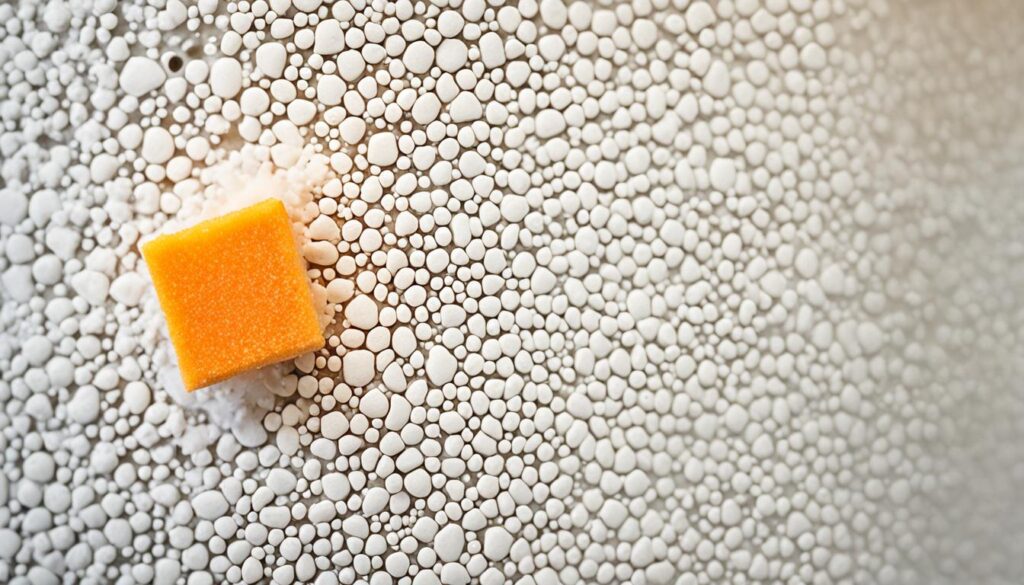
Mastering the Art of orange Mold in shower
Welcome to our comprehensive guide on the prevention and removal of orange mold in showers. Dealing with this unsightly and potentially hazardous issue can be a real challenge, but with the right knowledge and strategies, you can keep your bathroom pristine and healthy. In this article, we will explore expert tips and techniques for effectively preventing and removing orange mold, ensuring that your shower environment remains clean and safe.
Key Takeaways:
- Orange mold in showers can be prevented and removed by implementing proper ventilation, frequent cleaning, waterproofing measures, and reducing humidity levels.
- Understanding the causes and effects of orange mold is crucial for effective prevention and removal.
- Orange mold thrives in warm and damp environments, making bathrooms an ideal breeding ground.
- Moisture is a key factor contributing to the growth of orange mold, emphasizing the importance of keeping your shower area dry.
- Removing orange mold requires the use of suitable cleaning agents and protective gear, and in some cases, professional assistance may be necessary.
By following the advice provided in this guide, you can conquer the challenges posed by orange mold and maintain a clean, safe, and healthy environment in your bathroom. Now, let’s dive into the details and explore how to prevent and remove orange mold effectively.
Understanding Orange Mold in Shower
In this section, we will provide a comprehensive understanding of orange mold in showers. We will explore what exactly orange mold is, why it commonly appears in shower environments, and the potential health hazards it poses. Additionally, we will delve into the key factors that contribute to the growth of orange mold, such as moisture and a warm and damp environment.
Orange mold, also known as shower mold, is a common problem that many homeowners encounter. It is characterized by its orange or reddish color and typically thrives in warm and damp environments, such as bathrooms. The constant exposure to moisture in showers creates an ideal breeding ground for the mold to grow.
Not only is orange mold unsightly, but it can also pose serious health hazards. When mold spores are inhaled or come into contact with the skin, they can trigger allergic reactions, respiratory issues, and even infections. It is crucial to understand the causes of orange mold growth and take proactive steps to prevent its proliferation in your shower.
Key Factors Contributing to Orange Mold Growth
- Moisture: Excess moisture is the primary factor that promotes the growth of orange mold. Leaky pipes, inadequate ventilation, and improper sealing of shower fixtures can create a moist environment that orange mold thrives in.
- Warm and Damp Environment: Orange mold prefers warm and damp conditions to grow and spread. The combination of high humidity levels and stagnant air in the shower creates an ideal habitat for mold spores to take hold and multiply.
Potential Health Hazards
Exposure to orange mold can have detrimental effects on your health. Here are some of the potential health hazards associated with orange mold:
- Allergic Reactions: Orange mold can trigger allergic reactions in susceptible individuals, causing symptoms such as sneezing, coughing, itching, and redness.
- Respiratory Issues: Prolonged exposure to orange mold spores can lead to respiratory problems, including asthma attacks, wheezing, and difficulty breathing.
- Infections: In some cases, particularly in individuals with weakened immune systems, orange mold can cause infections when it enters the body through open wounds or cuts.
Understanding the causes and potential health risks associated with orange mold in showers is crucial for effective prevention and maintenance. In the next section, we will explore essential techniques to prevent the growth of orange mold and keep your bathroom clean and healthy.
Preventing Orange Mold Growth
In order to effectively prevent the growth of orange mold in your shower, it is important to implement several key preventive measures. By following these tips, you can ensure a clean and mold-free environment in your bathroom.
1. Proper Ventilation
One of the most important steps in preventing orange mold growth is to maintain proper ventilation in your shower area. Ensure that the bathroom is well-ventilated by installing an exhaust fan or opening a window to allow air circulation. This helps to remove excess moisture and prevent the growth of mold.
2. Frequent Cleaning
Regular and thorough cleaning of your shower is crucial for mold prevention. Use a mildew and mold-resistant cleaner to scrub the walls, tiles, and grout. Pay close attention to areas prone to moisture build-up, such as corners and crevices. Remember to also clean shower curtains or liners regularly to prevent mold growth.
3. Waterproofing
Waterproofing your shower area is an effective way to prevent mold growth. Apply a high-quality waterproof sealant to the walls and floor to create a barrier against moisture infiltration. This helps to minimize the risk of mold growth and keeps your shower area dry and hygienic.
4. Reducing Humidity
Reducing humidity levels in your bathroom is key to preventing mold growth. Use a dehumidifier to remove excess moisture from the air, especially in areas with high humidity. Additionally, you can open a window or use a fan to improve air circulation and reduce humidity levels.
“Proper ventilation, frequent cleaning, waterproofing, and reducing humidity are crucial preventive measures to keep your shower area mold-free and healthy.”

By implementing these prevention tips and taking proactive measures, you can significantly reduce the likelihood of orange mold appearing in your shower. Maintaining a clean and mold-free environment not only contributes to the overall hygiene of your bathroom but also helps prevent any potential health hazards associated with mold growth.
Removing Orange Mold from Shower
When it comes to tackling orange mold in your shower, it’s important to employ safe and effective removal methods. In this section, we will explore various techniques and cleaning agents that can help you get rid of orange mold effectively. Additionally, we will emphasize the importance of using protective gear during the cleaning process and provide guidance on when it’s necessary to seek professional assistance for mold removal.
1. Cleaning Agents
Choosing the right cleaning agents is crucial for effectively removing orange mold. Opt for mold-specific cleaners that contain ingredients like hydrogen peroxide, bleach, or vinegar. These agents are known for their mold-killing properties. Remember to follow the instructions provided by the manufacturer and test the cleaner on a small, inconspicuous area before applying it to the entire affected area.
2. Protective Gear
Protective gear is essential to ensure your safety while removing orange mold from your shower. Mold spores can be harmful when inhaled or come into contact with the skin. Prioritize your safety by wearing gloves, goggles, and a mask that filters out mold spores. This will protect you from potential health risks and minimize exposure to the mold during the cleaning process.
3. Removal Techniques
When tackling orange mold in your shower, it’s important to follow proper removal techniques. Start by thoroughly scrubbing the affected areas using a brush or sponge. Pay attention to any porous surfaces such as grout or caulk lines, as mold can penetrate these areas. Rinse the area with clean water and dry it thoroughly to prevent mold regrowth.
4. Professional Assistance
While DIY methods can be effective for small and isolated cases of orange mold, there are instances where professional assistance is necessary. If the mold covers a large area, is recurring despite repeated cleaning attempts, or if you have underlying health conditions, it’s best to seek the expertise of mold removal professionals. They have the necessary equipment and experience to safely address the mold issue and ensure its complete removal.
Remember, safety should always be your top priority when dealing with mold. If you’re unsure about the severity of the mold problem or have concerns about the removal process, don’t hesitate to consult with a professional.
By following these effective removal methods, using appropriate cleaning agents, wearing protective gear, and knowing when to seek professional assistance, you can ensure a thorough and successful removal of orange mold from your shower.

Conclusion
In conclusion, understanding the causes and effects of orange mold in showers is essential for tackling this common issue. By implementing preventive measures such as proper ventilation, frequent cleaning, and reducing humidity levels, you can significantly reduce the likelihood of orange mold growth in your bathroom. Additionally, proper cleaning techniques and the use of appropriate cleaning agents and protective gear are crucial when removing orange mold from your shower.
By prioritizing the well-being of your bathroom, you can maintain a pristine and healthy environment for yourself and your loved ones. However, if you find yourself in need of professional assistance or a mold assessment, don’t hesitate to contact Fix Mold Miami, Florida’s Highest Rated In Mold Assessments, Prevention, and Remediation at 305-465-6653. Their team of experts can provide the necessary expertise and services to address any mold-related concerns you may have.
Remember, by staying informed and taking proactive measures, you can conquer the challenges posed by orange mold and keep your shower mold-free for years to come.




